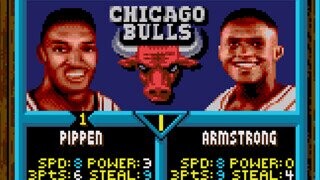NBA Jam: The Shady Reason The Bulls Couldn't Beat The Pistons

The companies that make sports games nowadays crank out new installments with ease. They don't need to worry about tweaking gameplay; they've pushed that as far as they want and see no need to improve it. Unlike with most types of games, art doesn’t really matter, even if graphics can always get marginally more photorealistic. Mostly, development consists of thinking up new, creative ways to convince players to pay additional money on top of the base game's cost.
Go back 30 years ago, though, and it was a very different story. We're thinking about when Midway Games was creating the original NBA Jam, and every aspect of translating basketball to an arcade game was a challenge. For starters, they wanted the players onscreen to look like actual basketball players—more so than, say, the cartoon jerkiness of predecessor Arch Rivals from a few years before:
3-D graphics weren't an option, but NBA Jam did have a plan for capturing the movements of real basketball. They filmed amateurs playing basketball in front of a blue screen and then digitized those images to use them in the game. It was a great plan, and we're pretty sure that was the premise of at least one Space Jam movie. Except, the players wore blue uniforms, against a blue screen. So instead of winding up with automatically isolated player images, the programmers at Midway had to go through the footage and outline the players frame by frame.
Don't Miss
Convincing the NBA to license their name was a challenge, as was getting individual players. Michael Jordan pulled out, wanting to go his own way separate from any league deal (later, he wanted in after all, once NBA Jam was a huge success). Getting gamers to recognize those licensed faces was another obstacle. NBA Jam experimented with making the heads disproportionately large, and while that was too silly even for this not-totally-serious game, they kept it as an alternative mode, and dozens of other games followed suit.
Gameplay balance took a lot of work, more than we have time to describe here. In a couple cases, you might say NBA Jam solved the problem by cheating.
Sometimes, players would far outscore their opponents, and other times, they'd find themselves trailing by a lot. Neither situation was good for convincing them to keep playing for long, so NBA Jam created "on fire mode," which can quickly bridge score gaps. Lots of games offer such ways to give advantages to whoever's behind (it's called "rubberbanding"), but it sounds a little more insidious when you realize the motive was to convince the gamer to keep dropping quarters in the machine.
And while the game used real stats to determine how NBA players perform, they also threw in one secret kink. When the Chicago Bulls played the Detroit Pistons (say, Scottie Pippen going up against Isiah Thomas), and the game came down to the last second, the Bulls would automatically miss the final shots.
The reason? Creator Mark Turmell was a Pistons fan, that's all. Incidentally, Midway operated out of Chicago, but that just made him hate the Bulls even more.
No one knew for certain at the time that the game was rigged. If anyone was suspicious, that didn't hurt the game's success. It took in more than $1 billion in its first year.
Top image: Midway Games
